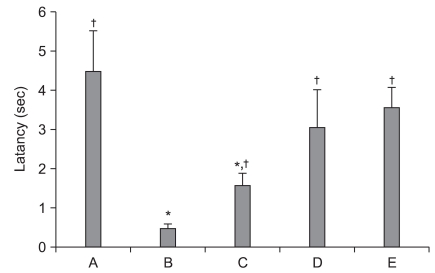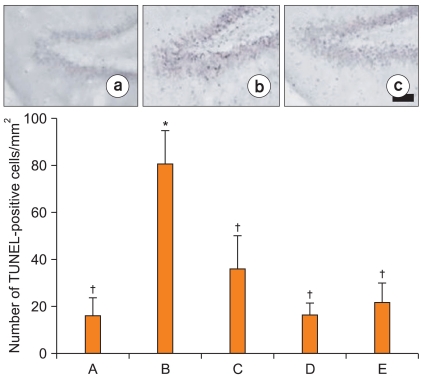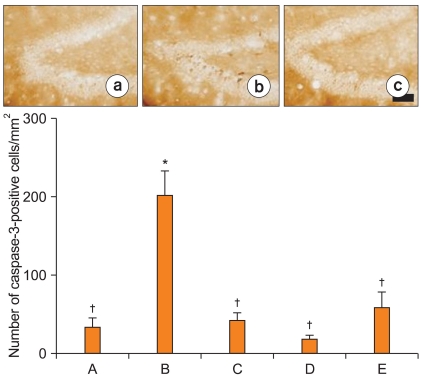Introduction
Materials and Methods
Experimental animals and treatments
Induction of transient global ischemia
Step-down avoidance task
Tissue preparation
TUNEL staining
Caspase-3 immunohistochemistry
Data analysis
Results
Effect of remifentanil on latency during the step-down avoidance task
 | Fig. 1Effect of remifentanil on latency of a step-down avoidance task following transient global ischemia in gerbils. Results show that remifentanil alleviated ischemia-induced memory impairment. Data shown are the mean ± SEM. *P < 0.05 compared to the sham-operation group. †P < 0.05 compared to the ischemia-induction group. (A) Sham-operation group, (B) ischemia-induction group, (C) ischemia-induction and 0.02 mg/kg remifentanil-treated group, (D) ischemia-induction and 0.2 mg/kg remifentanil-treated group, (E) ischemia-induction and 2 mg/kg remifentanil-treated group. |
Effect of remifentanil on the number of TUNEL-positive cells in the dentate gyrus
 | Fig. 2Effect of remifentanil on DNA fragmentation in the dentate gyrus following transient global ischemia. Results show that induction of ischemia increased apoptotic neuronal cell death in the dentate gyrus and treatment with remifentanil inhibited ischemia-induced apoptotic neuronal cell death. Upper: Photomicrographs of terminal deoxynucleotidyl transferase-mediated dUTP nick end labeling (TUNEL)-positive cells. (a) Sham-operation group, (b) ischemia-induction group, (c) ischemia-induction and 0.2 mg/kg remifentanil-treated group. Scale bar represents 25 µm. Lower: mean number of TUNEL-positive cells in each group. Values shown are the mean ± SEM. *P < 0.05 compared to the sham-operation group. †P < 0.05 compared to the ischemia-induction group. (A) Sham-operation group, (B) ischemia-induction group, (C) ischemia-induction and 0.02 mg/kg remifentanil-treated group, (D) ischemia-induction and 0.2 mg/kg remifentanil-treated group, (E) ischemia-induction and 2 mg/kg remifentanil-treated group. |
Effect of remifentanil on caspase-3 expression in the dentate gyrus
 | Fig. 3Effect of remifentanil on caspase-3 expression in the dentate gyrus following transient global ischemia. Results show that induction of ischemia increased caspase-3 expression in the dentate gyrus and treatment with remifentanil inhibited ischemia-induced increase in caspase-3 expression. Upper: Photomicrographs of caspase-3-positive cells. (a) Sham-operation group, (b) ischemia-induction group, (c) ischemia-induction and 0.2 mg/kg remifentanil-treated group. Scale bar represents 25 µm. Lower: number of caspase-3-positive cells in each group. Values shown are the mean ± SEM. *P < 0.05 compared to the sham-operation group. †P < 0.05 compared to the ischemia-induction group. (A) Sham-operation group, (B) ischemia-induction group, (C) ischemia-induction and 0.02 mg/kg remifentanil-treated group, (D) ischemia-induction and 0.2 mg/kg remifentanil-treated group, (E) ischemia-induction and 2 mg/kg remifentanil-treated group. |




 PDF
PDF Citation
Citation Print
Print


 XML Download
XML Download